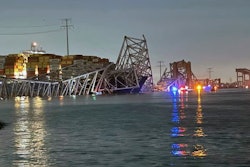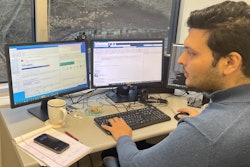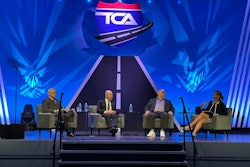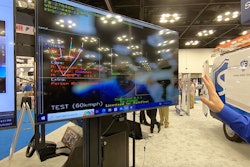Penske Transportation Solutions last month published the results of its 2022 Telematics Use and Trends study, which examined who is using telematics devices and how fleet decision makers choose technology and use the information it generates.
Joining Jason and Matt this week on the 10-44 are Samantha Thompson, Penske Transportation Solutions vice president of customer success and fleet telematics, and Brandie Searle, vice president of digital product management for Penske Transportation Solutions, who talk about the results of the study and how fleets can leverage telematics to improve their bottom line.
Contents of this video
00:00 The use of telematics systems by trucking companies
02:24 What are telematics?
04:37 Factors fleets consider when shopping for a telematics device
06:51 Telematics give fleet managers more visibility
09:38 Telematics can help roadside technicians
11:00 Recent telematics growth in small fleets
13:07 Penske’s consulting service is available to help fleets
Jason Cannon
This week's 10-44 is brought to you by Chevron Delo 600 ADF ultra low ash diesel engine oil. It's time to kick some ash.
Matt Cole
How fleets are leveraging telematics to improve their bottom line.
Jason Cannon
Hey everybody. Welcome back to the 10-44, a weekly episode from the editors right here at CCJ. I'm Jason Cannon and my co-host on the other side is Matt Cole. The use of telematic systems by trucking companies has grown exponentially in recent years, and it continues to grow today. Just because a trucking company has a telematic system doesn't necessarily mean that they're leveraging all the data that it can provide.
Matt Cole
A recent study by Penske Transportation Solutions takes a look at which fleets have adapted telematics, why they chose the systems they did, and how they're using those systems. This week on the 10-44, we're joined by Samantha Thompson, Penske Transportation Solutions Vice President of Customer Success and Fleet Telematics, and Brandie Searle, Vice President of Digital Product Management for Penske Transportation Solutions, who talks about the key findings of the survey.
Brandie Searle
My name's Brandie Searle. I've been with Penske now for 22 years. I'm the Vice President of Digital Product Management, and what that means is I focus on developing all of our customer facing tools, and specifically to this call that involves utilizing information that comes from the vehicle and then helping our customers make insight out of all the data that's available right now.
Samantha Thompson
My name is Sam Thompson. I've been with Penske a little over 10 years, and I am the Vice President of Customer Success and Fleet Telematics. That's really just a fancy way of saying I geek out all day. But my team is responsible for helping customers to adopt the solutions that Brandie's team develops, and also solutions that we don't develop in-house, such as telematics systems, cameras, and so on. Part of my role is also helping Penske to make informed decisions about connectivity for our own fleet as well. I would say it's a new study. We've done surveys before to certainly try to understand what our customer base is using, but this is a little bit more broad and more thorough to get a better understanding of not only what our customers are using, get a sample of what's happening in the industry. We're seeing quite a bit of adoption, and some of that's driven by regulations, but sometimes it's also just fleets getting more savvy and getting more access to technology as well.
Jason Cannon
There isn't really a specific definition of telematics, services vary by provider. But there are some features that are pretty common across the board.
Samantha Thompson
There are multiple flavors of telematics. I think the umbrella is pretty broad, and it can include even things that aren't traditional telematics, like fleet management solutions. I think you think of it more broadly as like these transportation technology solutions, which is inclusive of telematics. It could be ELDs, it could be GPS tracking, and it could be fleet management tools and so on. But the top reasons that customers still tend to adopt onboard technology or telematics, if you will, it's still very much compliance, safety, and efficiency. They want to comply with the regulations that are placed upon them. They want to make sure their drivers get home safe every night and they want to drive operational efficiency. They want to save money on fuel and a number of other things.
Matt Cole
There are dozens, if not hundreds of telematics devices on the market for fleets to choose from. And Penske found there are a number of factors that fleets tend to consider when shopping for a device. We'll hear more on that after a word from 10-44 sponsor, Chevron Lubricants.
Jason Cannon
Protecting your diesel engine and its aftertreatment system has traditionally been a double-edged sword. The same engine oil that is so essential to protecting your engine's internal parts is also responsible for 90% of the ash that is clogging up your DPF and upping your fuel and maintenance costs. Outdated industry thinking still sees a trade-off between engine and emission system protection, and Chevron was tired of it. So they spent a decade of R&D developing a no compromise formulation. Chevron lubricants developed a new ultra low ash diesel engine oil that is specifically designed to combat DPF ash clogging. Delo 600 ADF with omnimax technology cuts sulfate ash by a whopping 60%, which reduces the rate of DPF clogging and extends DPF service life by two and a half times. And just think what you can do with all the MPGs you're going to add from cutting your number of regions. The Delo 600 ADF isn't just about after treatment. It provides complete protection, extending drain intervals by preventing oil breakdown. Before you had to choose between protecting your engine or your after treatment system, and now you don't. 600 ADF from Delo with omnimax technology, it's time to kick some ash.
Samantha Thompson
Besides the main reasons that customers typically adopt telematics, why they go to a specific provider over another. Honestly, a lot of it's word of mouth. They hear from their peers what they're using and they trust that experience or they were working at another organization and they were already using a specific solution. It's really referral or previous experience. But we're seeing a lot of more of adoption with these newer technologies, and that's because customers are looking for more capabilities. They want things to be more consolidated into a single platform. They want more visibility into what's going on with their fleet. It's getting more and more challenging to manage a fleet, small or large, without visibility and that technology and that real time data that can be sent to you. So more often than not, it's someone told me this was a good idea or I had this experience that there aren't many organizations out there that provide a consulting service like we do, where we're taking an inventory of where a customer's starting point is and where they want to go, what are your goals? What are your needs? What are your challenges? And use that to inform which recommendations we'll put in front of them.
We're one of the few organizations that do that, I believe. But yeah, other than that word of mouth and referrals and previous experience leads them to one provider over another. Price is still a factor, but again, that's the changing quite a bit as well.
Brandie Searle
That's one of the challenges that customer customers face is there are so many options out there, and I think one of the things that customers really need to focus on is why are they adopting the technology? Because there are so many variations in the data that's available, the features that are offered. And as Sam mentioned, right, that's one of the things that we try to help our customers do. But regardless of Penske or not, what customers really need to focus on is why am I adopting this technology? And therefore pick the right solution and the best solution that fits their needs. Like Sam mentioned, are they looking at compliance? Well, then there's some solutions that cater a little bit better to compliance. Is it simple visibility, right? Well, then they might be able to go with potentially a lower cost solution. So I think really having the customer understand what they're looking for is key to picking the right technology with all the options that are out there in the market right now.
Jason Cannon
One of the biggest ways that Penske found telematics are helping fleets is with maintenance and giving fleet managers more visibility into the health of their trucks.
Samantha Thompson
It goes along that line of visibility. You don't know what you don't know until it's in front of you, and a lot of these telematic systems are baking in fleet management capabilities, so customers can have a line of sight on when their maintenance is due, even get some key information about the severity of certain issues. We're even leveraging the information from these telematic systems internally so that we can be better at what we do, which is ultimately our core competency is maintenance. And our customers adopting technology and sharing the key data points with us allows us to be better at what we do as far as servicing those vehicles and keeping them up and operating and in their hands and out of our shops. But yeah, as far as the study goes, we're finding that, just exactly what Brandie was touching on, is that customers now have more visibility to what's going on, but it's still that they need more help taking action on those things.
So they still need to partner with someone who is going to see that this maintenance is due, see that there's an issue going on, and ultimately do something about it. So it's great that customers have more visibility, just taking it that step further and making it an actual thing that can be done. And by integrating with Penske, that's certainly a way to go about it.
Again, starting first and foremost with visibility. And some of these solutions do provide, go so far as say it's diagnostics. They do provide some visibility as to, Hey, there's an issue going on, and some of them start talking about severity, but I would still say they're still maturing to do as far as being able to do true diagnostics and understand exactly what is going on with the information that's being presented to a customer. That's one of the things that our customers are challenged with this.
Sometimes they see too much and it becomes noise and they don't get a lot of insights from the information. So while it can help provide that visibility and say, Hey, someone needs to take action on something, being able to unpack it and understand and know what that action should be, those systems are a way off from that, and that's where our capabilities come into play. Again, yes, tell our customers if something's going on, but tell us too so that our experts can go ahead and start making informed decisions on how to remedy that issue or, Hey, this is severe, let's take care of it now. Or you know what? This can wait until your next preventative maintenance interval. So yes, it does make it easier. It does give our customers more visibility, but that piece, taking it to that next level that we were just talking about as far as the action and understanding what's being shown to you because the fault code being shown in your system, it doesn't necessarily mean that it's a bad thing. How many times has that fault code grown? How severe is that fault code?
And the telematics systems, while they can deliver the information, they still have some work to do as far as understanding what's being delivered and then recommending what should be done about it.
Matt Cole
Telematics can also help fleets when they have a breakdown. Roadside techs can draw on telematics data to arrive better prepared to address the root cause of the breakdown to get the truck back on the road faster
Brandie Searle
When it comes to the information that we are able to get from a telematics solution to make use of, I think it really helps in three key areas. We touched a little bit on when there's scheduled maintenance and a vehicle comes into the shop, it can help us know exactly what needs to be taken care of.
I think two other things that are often overlooked is if a customer does suffer a breakdown along the side of the road and a service provider needs to go out to the customer, the telematics will actually show us exactly where is that vehicle and what's going wrong. So if there's an event alongside the road, it greatly increases the speed with which that vehicle can get back up on the road. And then in the ideal case, and this is maybe a little future looking, but if we have that information coming from the vehicle, we can take care of issues before they even occur. So it doesn't maybe require an additional maintenance stop or in best case scenario, it would prevent a potential breakdown along the road. So I think in all three of those facets, the scheduled maintenance, the roadside event, as well as that proactive type of maintenance, I really think it helps all three of those things.
Jason Cannon
Historically, telematics have primarily been used by large fleets. Penske found that more than 50% of large and medium sized fleets are using telematics, while only about 37% of small fleets are using them. But the ELD mandate and load tracking requirements along with technology getting a little cheaper has spurred recent telematics growth among the small fleets.
Samantha Thompson
A lot of it is cost, and traditionally, historically, telematic systems were quite expensive, and the larger fleets got there first, right? They saw the value and they had the funds actually to start equipping their fleets many years ago, even before insurance companies started recommending it, even before the ELD mandate required it, or there was a lift from using technology for things like FSMA. They got there first and they could afford to do so. That kind of started the gap. The small fleet, again, margins being slim, they couldn't justify putting in technology that they wouldn't necessarily see the ROI immediately. They'd have to wait a bit to start seeing, okay, I've invested this and now it's starting to help me and I'm getting return on things. We're starting to see, I would say, more adoption just generally speaking in the transportation industry. But again, those larger fleets had the funds and needs to get there sooner, and larger fleets have the staff to operate these systems.
But we are starting to see more roles that are requiring people to be more tech-savvy and actually use these platforms as like a command center. We go out and visit our customers and they have rooms dedicated to telematics system. They have big screens up, and they can see their trucks on the map. They can see what maintenance is going on, they can see when the deliveries are being made. And it's becoming more and more integral and less of a value add. And I would attribute a lot of that to the ELD mandate because customers did get telematics because they had to, but they also then started to see some of the additional benefits. It's like, okay, I have to get this thing and pay for it, but now, oh, wow, I could do this other thing too, and then it starts to essentially pay for itself. So yes, ELD may have been a headache and a frustration, and they didn't want to do it, but then they're like, oh, this device does a lot more than I thought it did, and it's actually become quite integral to my operation.
Matt Cole
Samantha and Brandie said that Penske has a consulting service available to fleets looking to bring telematics into their operations to help with the purchasing and installation process and beyond.
Samantha Thompson
I'd like to highlight the consulting service that we offer. Again, there are so many options out there and our customers are using a fair share of them, and it does get pretty complex as far as selecting an option. Like Brandie said, start small, know your why. All these things are key things. But if you are a Penske customer, there is a whole team dedicated to helping you to navigate the landscape of all these things that are out there. Not only do we help you to understand your options, we'll help you to identify the best option for your fleet. We'll help you to purchase, install, and then ultimately, if it's a provider that integrates with Penske, we'll help put that data to work here at Penske so that we could be a better partner and provider.
Brandie Searle
From the product side, what I can add is we've used the word visibility a lot, and obviously telematics provide a great deal of visibility to everything going on with a truck or a fleet. I think one of the key words I would use in addition to visibility is also the insights, right? We've talked about the volume of data. And for larger customers that maybe have a group of people that can look into it, they can generate their own insights. But for those small and medium sized companies, I think having a partner like Penske that can take that data and then make it usable and highlight what you need to focus on and provide those key actionable insights is so important. Because again, the volume of information coming off these vehicles, coming off these fleets now can be tremendous. And so it's not only the visibility, although visibility is key, right? But I think it's not just visibility, it's also the actionable insights that you can derive from that information.
Jason Cannon
That's it for this week's 10-44. You can read more on ccjdigital.com. And as always, you can find the 10-44 each week on CCJ's YouTube channel. And if you've got questions, comments, criticisms or feedback, please hit us up at [email protected] or give us a call at 404-491-1380. Until next week, everybody, stay safe.










